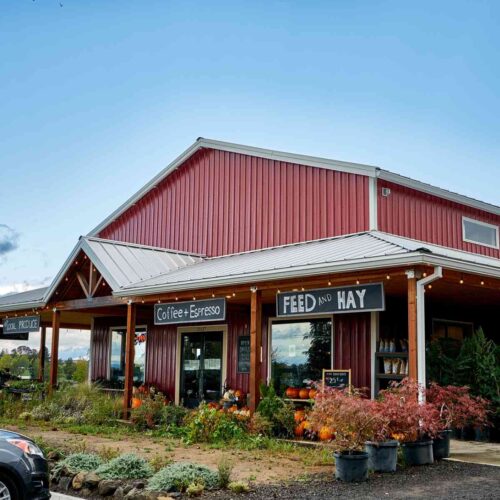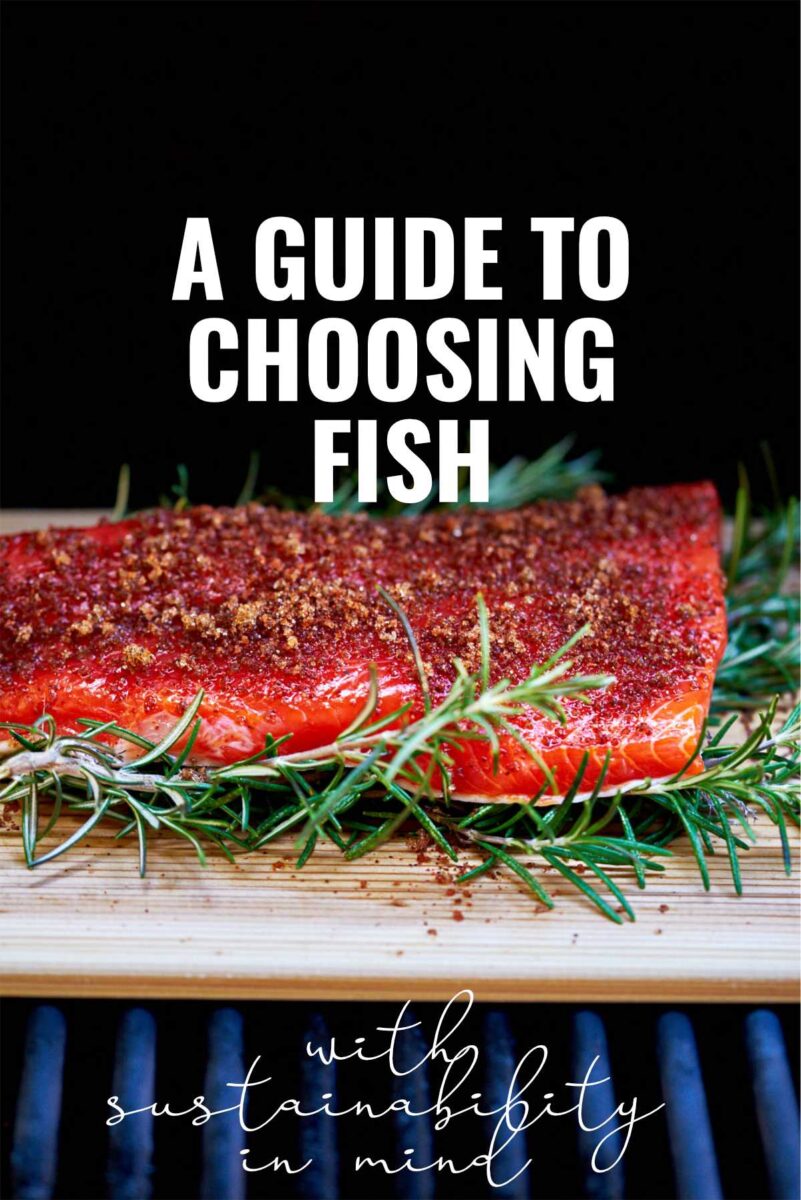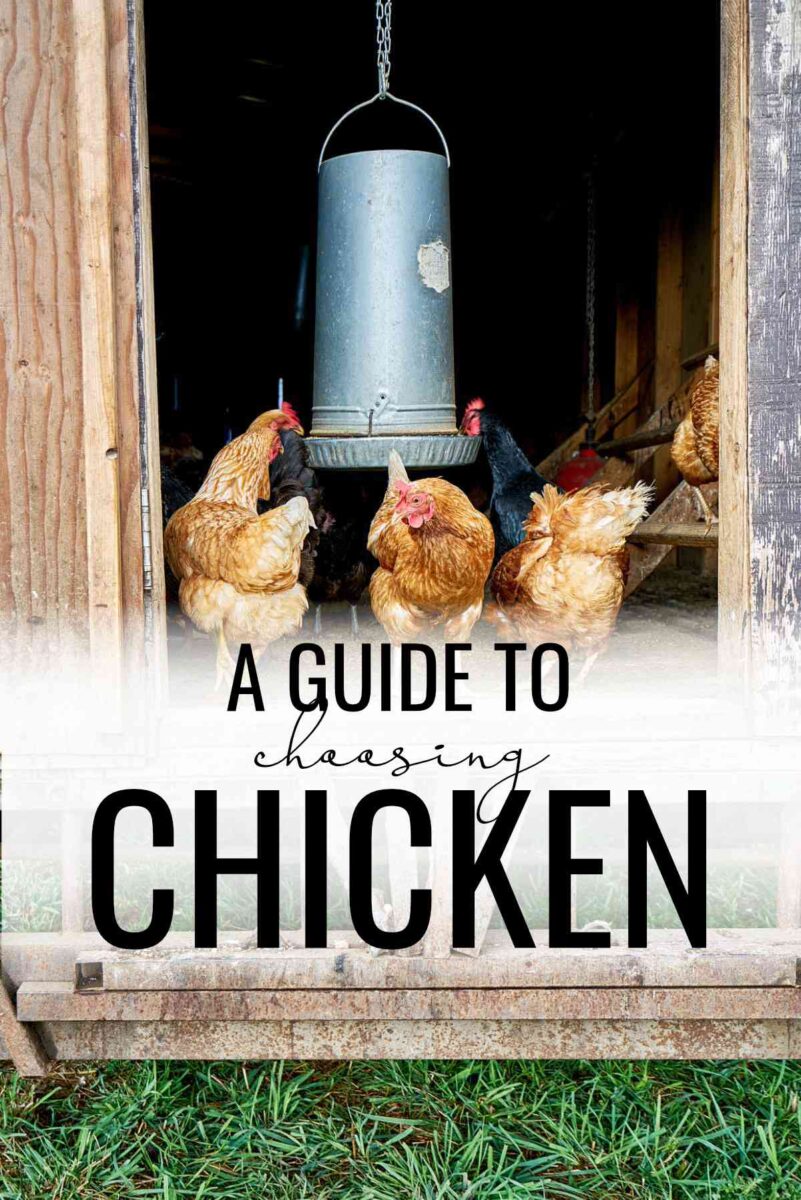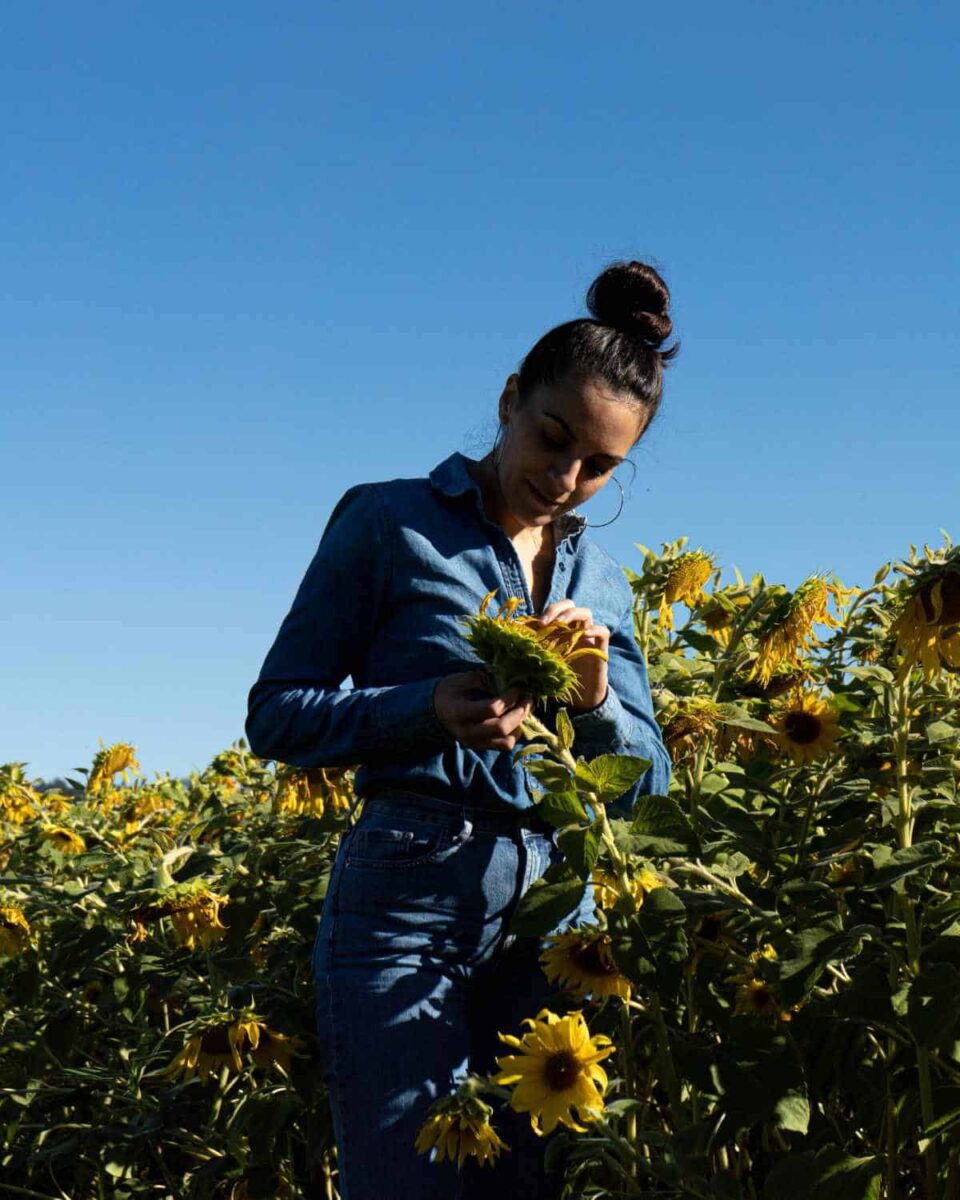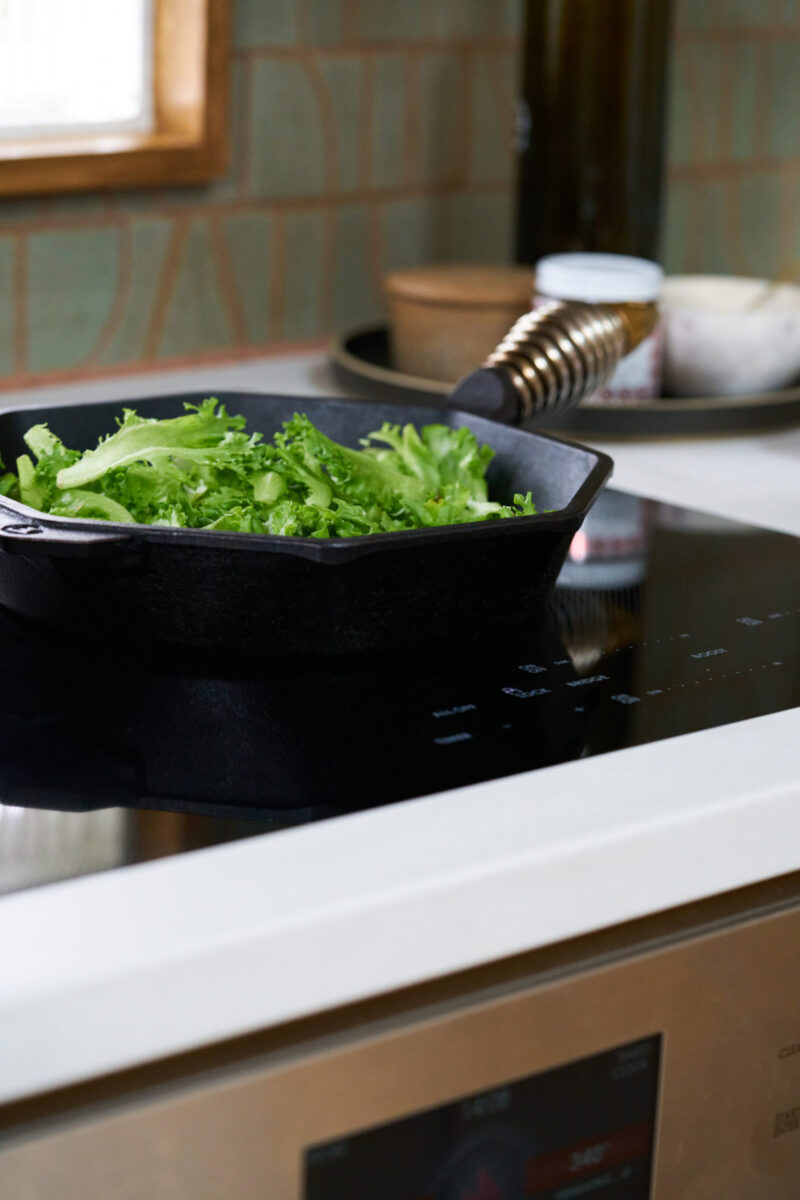This is the automated transcript of Candice Walker in conversation with Geoff Scott and John Mathia of Marion Acres and Helvetia Market in Hillsboro, Oregon.
Parts of this transcript have been paraphrased in the article, A Guide to Choosing Chicken, where I help you understand the types of chicken you can buy, so you can make the best choice for you and your family.
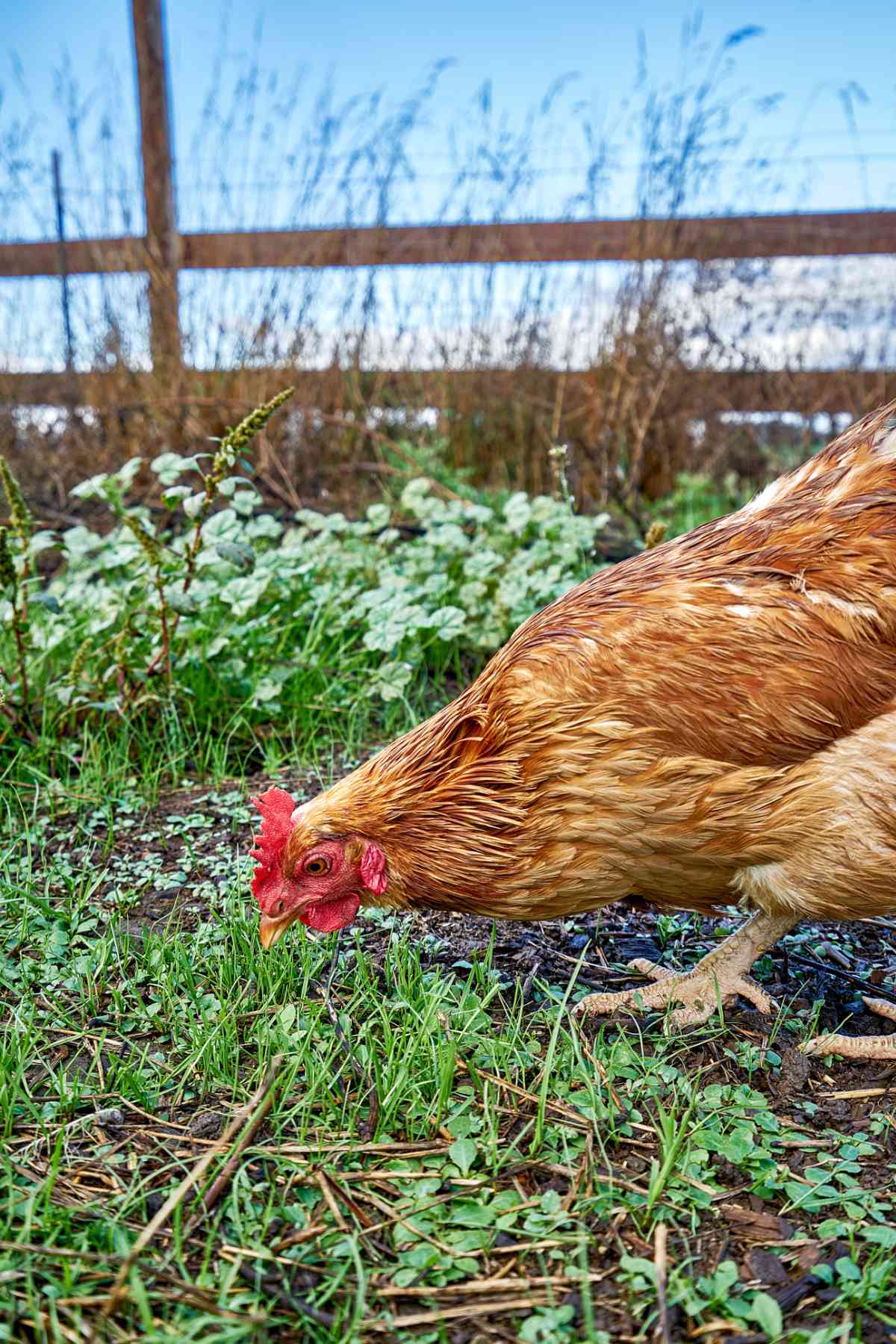
00:01:05:12 – 00:04:02:12, Marion Acres Approach to Farming
Candice: I do want to say the point of this article isn’t to talk about all the problems because…You feel free to talk about any. Personally, I love talking about it. I think people need to know about it. I just want you to know that’s not what I’m focusing on. I want to focus on what’s being done right. And give people the tools they need because it’s easy to watch these documentaries that show you these horrifying things that are happening. And then you go to get to the grocery store and you don’t know what to do. So that is what I’m trying to help with. So just generally speaking, maybe aside from what’s on your website, what would you say Marion acre’s approach to chicken farming is?
John: Sustainable, holistic, different.
Geoff: Let the chicken be the chicken. Right?
John: Smaller scale. Definitely smaller scale than what is out there.
Geoff: Honest. I think, so a big part of that is that people can come here again and again.
Geoff: Yeah. People can come here and see exactly what’s going on, right? So whatever words or phrases we use doesn’t really matter to some extent. If you’re standing here watching us do all of the chicken. It’s pretty simple.
John: Yeah, I was just showing Geoff the other day pictures of possibly chicken farms or hog farms in the middle of the desert. I mean, Nevada and Utah, and it’s just desert out there. But these little patches of green zoomed in. I was like, Oh man, there’s a chicken house there and there’s like thousands of chicken houses, and I can’t imagine how many chickens are in one of those houses.
Geoff: You know, millions of chickens in one photo
John: All the energy to go in and keep them cool if it’s hot in the summer and warm if it’s cold in the winter and the water and the wastewater and they can get around the wastewater regulations out there because it’s desert.
Geoff: Yeah, you know why mega dairies and poultry and swine houses are out in the desert, feedlots two in particular, there’s zero, well not zero chance, but a very low probability that they will impact groundwater because there is no groundwater. You couldn’t do that here in the valley.
Candice: I assumed it was to keep the smell away.
John: I mean. Well, that’s right. But you think about the resources required to keep animals alive in the middle of nowhere, and they do that simply because they can impact the environment more without having a measurable impact, if that makes sense.
John: I think the other big thing we’re doing here is education. Just educating people like this is how animals…I mean, it’s not actually 100 percent perfect, but it’s a better way. And educating people that eating meat shouldn’t be a daily three times a day thing. It should be, you know, a luxury. And it shouldn’t be done cheaply. If it’s done cheaply, it’s done wrong, if it’s done. I wouldn’t say we’re expensive, but it’s done affordably.
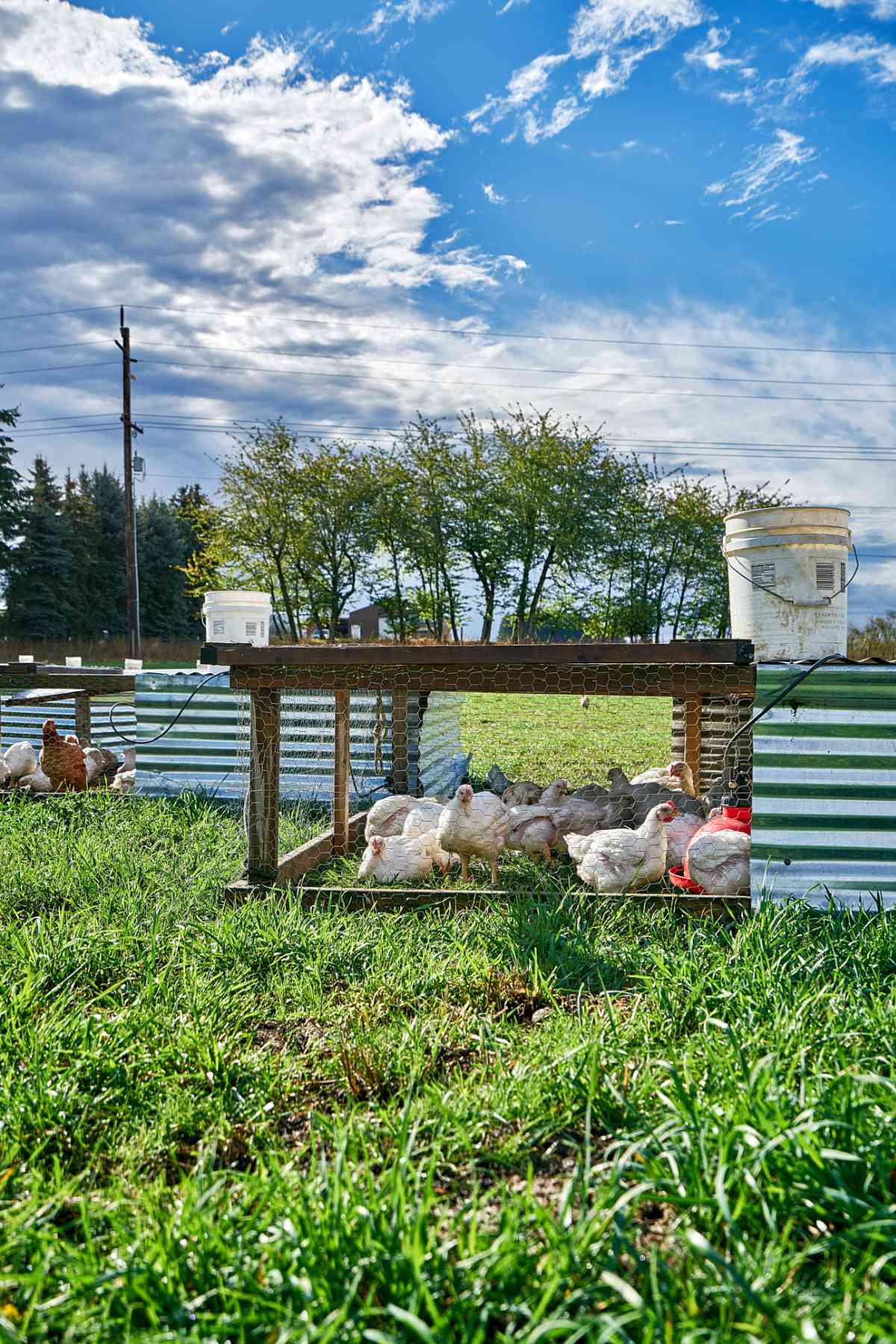
00:04:13:02 – 00:06:56:22, Widgets & Wages
Candice: You’re paying for what you’re getting, right?
John: Yeah, we’re paying for the lives of the people that work here, too. You know, there’s sustainable wages. There’s, you know, it’s healthier for the environment. I don’t smell what you smell at a chicken house.
Candice: They’re not, you know, trying to crank out widgets and not able to use the bathroom.
Geoff: And I think that the lie of cheap food has permeated our culture far, far too much. There’s no such thing as cheap food. And the bill comes due somewhere, right? And my personal belief is that the bill currently is coming due to the environment and labor. Both of those are being exploited in order to create, quote unquote, cheap food, here and many small farms all over the valley. The full cost? Is being measured at the cash register, so the fact that our chicken costs what it costs is because there’s no hidden cost and the bill isn’t going to come due 10 years from now when there’s a Superfund cleanup site here on the property because we used to be a chicken farm. The environment is being treated as not something to exploit.
Candice: You’re respecting the land.
Geoff: Yeah, and the workers, you know, they work really hard and the animals. Yeah, we’re at fault. So the point is, you know, expensive, cheap, whatever the full cost is, is being measured here. Whereas we’ve squirreled away a lot of the costs out of sight, out of mind and a lot of consumers for quote unquote cheap food, which doesn’t actually exist.
Candice: It doesn’t exist. And I’m sure you guys have spent a lot of time thinking about it as a chicken walks by right now, a couple of just coming to say hello on the farm right here. I have some awesome photos of them from a tour you guys gave last year, so I’ll be putting those in my article. But what do you guys see as a potential eventual solution to that? Because people can’t afford food right now? You know, and that’s kind of why cheap food arose because, you know, wages aren’t what they should be and what have you guys thought about?
John: Well, not to sound too socialist, but I think it’s a matter of the economy like, where are people going to put their money and what’s going to be more important for them is going to be they’re nice new Mercedes Benz. I’m sorry if you drive one now, but or is it going to be into the food to make them healthier so they don’t have health problems down the road, which it eventually will cost money? You know you get insurance. Well, it costs us all money for us to support a cheap insurance system or a cheap food system or anything like that. It’s all going to cost us in the end, you know? So I think that that’s the hard part is I think the American Way has been, you know, I’m totally for I’m totally American. I love freedom, I love capitalism. But I think there’s a better way for capitalists
00:07:00:06 – 00:11:17:27, Better Decisions About Our Food
Candice: Different choices that can be made right. We do have a nice car, but we’re a one car family, you know, and that was the choice that we made to be able to do that right. But, you know, not everyone has that option, right? Not everyone has the option to even buy that one nice car. And I feel like those people, especially in these food conversations, they do get left behind. And I don’t know. I just like, how do we support them in making a better decision about their food?
Geoff: So I think there’s quite a few things I can say about that. The first is why, why is corn syrup subsidized and carrots are not right? And I think that’s a policy government that’s a priority issue at a very high level that we’ve just prioritized commodity crops in the Midwest and we subsidize that. So now food producers are getting those food stock items at below the cost of production. Why can’t we do that for carrots? Why can’t we do that for broccoli, even though I am 100 percent anti-broccoli? Yeah, it should be treated the same way. I also think that culturally, I don’t know what happened, but you know, I’m sure we’ve all seen the statistics, right? So like fifty years ago, we were spending thirty five percent of our income on food and now we’re spending less than 15 or whatever.
Candice: I know and we’re spending a crazy amount on housing.
Geoff: and we’ve tipped into a subscription model for almost everything in our phone or Netflix or Amazon Prime or all of those other things. And you know, like John said earlier, we should be eating less meat, but we should be eating better meat. And that’s kind of… along with cheap food, was, you know, Oh, I can have strawberries in February, I can have chicken in April and I can have pork in February. Well, you know, maybe we shouldn’t be eating kind of the way that we’re eating right now. Maybe we should change the way every year. To take advantage of the seasonality. And I do think a lot about the single mom who’s working with three kids. You know, how does she make it work? And in my idea of, you know, how to make food affordable for everybody? Yeah, I do think a big part of that is the government stepping in and saying either end the subsidies, which is preferable right to the commodity crops or let veg and small agriculture participate in that same.
Geoff: I just read two books and so I got a lot of stuff in my head.
Candice: Yeah, I know. And that’s why I really wanted to not focus this article on what everyone’s doing wrong, because that content is there, you know? So it’s like, how do we help the people who are trying to make the right decisions?
John: Well, I mean, on those lines, maybe maybe getting away from the idea that I need to buy my food at the supermarket? Yeah. You know, maybe, maybe it’s really stressing and encouraging to go find a farmer.
Candice: It’s easy. In Oregon, it is.
Geoff: It is. Yeah, we’re in a valley in the valley.
Candice: We’re lucky. Not everyone has that luxury.
Geoff: I’m thinking that like, you know, like, Well, could you form a co-op and write, you know, make, you know, have like a drop point in the city? And I know there’s farms that have dropped points in the city? Yes. Let somebody who you know their first name grow food for you. Maybe that should be the goal. Not like walking across Costco, to get my rotisserie chicken
John: I mean, both Geoff and I didn’t like when we were kids, we were like, Hey, we want to be a farmer when I grow up… I think I wanted to be a fighter pilot for the Air Force, you know? I think Geoff was the same way we ended up becoming different things. But you know, it wasn’t until 12 years ago that we decided, Hey, let’s go, I want to be a farmer now full time and try this. And I think our example here of how we were quote unquote successful. I mean, is a good example for other people to follow in this area. Like, you can do this. You know, we’re not afraid of some guy down the road opening up a chicken farm. It’s like, Go ahead, do it. Let’s get more people like this.
Geoff: And can I tell you all of the lessons we’ve learned. So you don’t repeat the mistakes.
Candice: And I think that given the size of your land, this is something that can be replicated in other areas too. You’re not just down the street, right?
John: And we’re not and we don’t own the land. I’ll clear that up, but we have a great partner that we lease from. And I think finding people like that out there, there’s people out there that have land that’s just sitting fallow, that is and could be generating income for them, but also generate income for a farmer that could grow amazing food like we do.
Candice: And if they’re growing it the way that you guys are growing it, it’s also really good for the land, right? That’s right. Exactly.
Geoff: There’s a great one and I’m going to butcher it’s John Steinbeck quote from the Grapes of Wrath, I think. And it’s, you know, let a father drive past a fallow field with his starving wife and thin children in the backseat, and let him ponder the fact that that field cannot be put in production profitably and ask yourself, what is profit? You know, it’s like, Well, there’s a lot of fallow land out here that is just mowed once a year because people live on a fairly large…and you don’t need forty seven acres. John, I didn’t start here… we started across the street slash down in Woodburn, slash in our backyards. So that’s something that everybody could do, either some containers on your back patio or if you have a little balcony or whatever, you know, start somewhere and do what. You can grow a little bit of food yourself, and I think it’ll tune you into, Oh, you know, why does the tomato that I grow taste so wildly different to tomatoes in February? Yeah. You know, at the supermarket, that’s something that people can do it. Just do what you have now. Don’t be thinking, well, I can’t start a forty seven acre farm. Well, no, that’s not where John and I even started. We started in our backyard, and
00:13:04:14 – 00:17:07:23, Demand & Sustainability
Candice: We could just start to educate ourselves on why things are happening. And even, you know, some people don’t even understand why you shouldn’t be eating tomatoes off season. And just to learn that alone will make different choices at the grocery store that end up being more delicious and cheaper, actually. All right, let’s move on to another question. All right. How do you balance demand with your sustainable practices?
John: Well, demand is driven right now, mostly by the stores and the restaurants. So I wouldn’t say there is much demand there. One, again, it’s an expensive piece of chicken where, you know, down in California and wherever these bigger farms are, they’re providing a cheap chicken and we can’t compete against that. So I would say demand is there as people learn more about what we do. I think our demand grows.
Candice: I mean, your turkeys, for example, sell out.
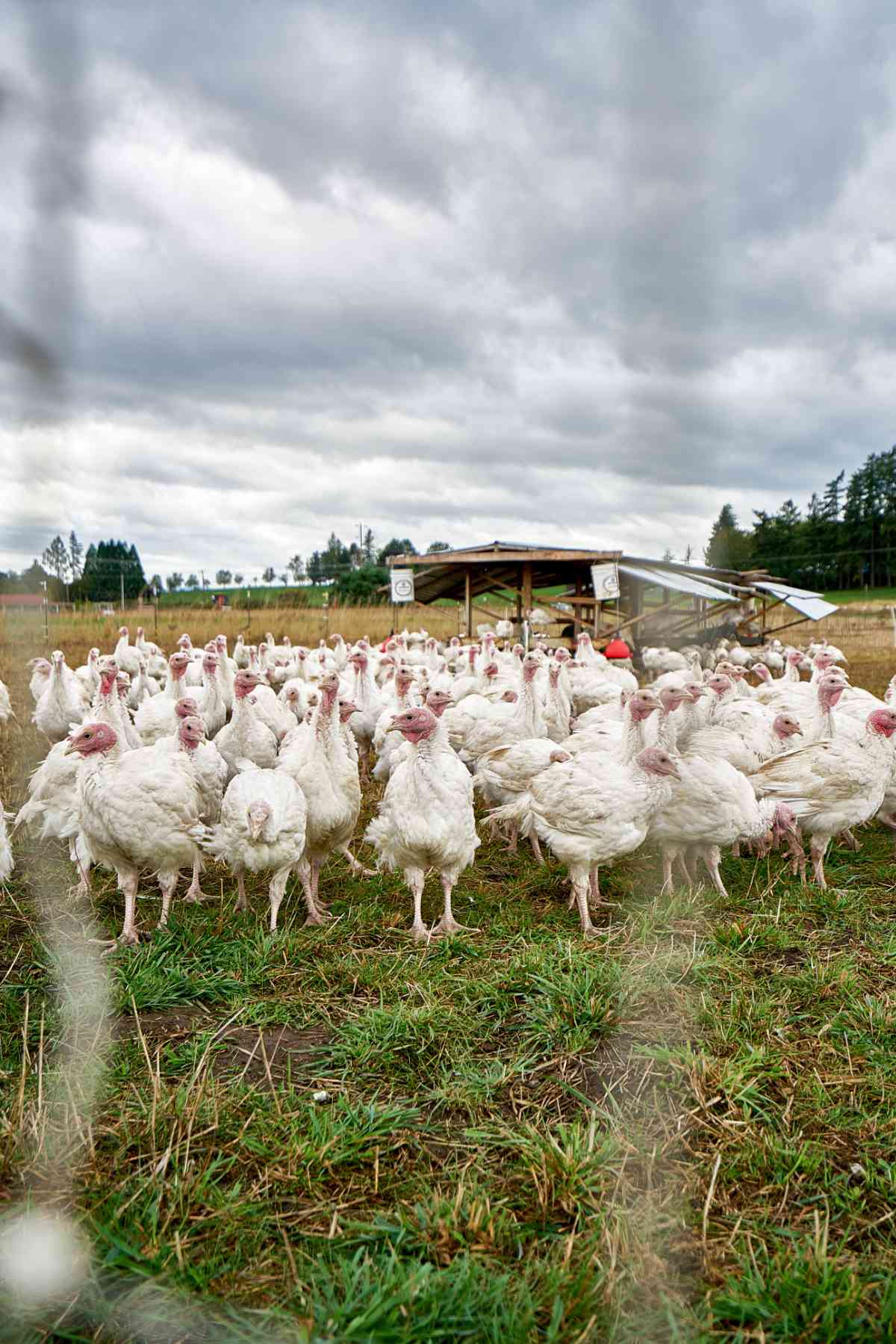
John: Well, yeah, there’s demand for that as well.
Geoff: And pork and beef, I think are good. Yeah, yeah. So turkeys do
Candice: This horrible COVID period aside with, you know, terrible things that have happened with the restaurant industry. You usually have more demand than your supply is my experience of. Oh, it’s so sad to think about it, it’s just not like that right now for you, is it
Geoff: Not on the not on the chicken, not on the chicken, but the bean? Still, everything else. I mean, we continue to scramble to meet the need.
John: But I think that the temptation is to grow big like we did that with chicken expecting 2020 to be an amazing year, right? Twenty one. Twenty twenty one. Well, we thought twenty twenty one was going to be a recovery year, but it hasn’t been. I mean, I I think the restaurants are still trying to recoup some of their their costs incurred by being this takeout place. So for us, it’s just a matter of, you know, you, you grow it to me. And if it’s there, but you gotta be you know, be wise about it. You can’t go crazy. Big, I mean, crazy big just stresses you out. You know, I think doing things that are really encouraging others to do it would be a better option because then you just kind of spur on competition. You spur on the fact that this is a normal thing instead of a, you know, a luxury thing. Yeah. So I think that might help change people’s minds about, you know, the food that they eat, where they get it from, like Geoff was saying earlier,
Geoff: Like in food in the documentary, you know, Joel Sultan is sitting there on his elbow and he’s got the pig feeder in the back and the hogs are kind of doing their thing. And it’s just it’s very bucolic, pastoral sort of when you sit there like chewing on a piece of grass or something, and he’s talking about how his biggest challenge is how to meet demand without compromising his principles, right? And so for years, I just thought that’s maybe what somebody would say to sound smart because I didn’t really believe it. But we definitely got to a point where like, Oh, I, I get that now I can see where if in the name of meeting more demand, you sacrifice principles. And it’s not like suddenly we’re giving antibiotics to everything…it’s a little bit here, a little bit there. And suddenly you’re off the path, you’re not on the path anymore. But it wasn’t one big step. It was like 10 small little steps. And I think kind of coming back to, OK, yes, we have the demand. How can we meet whatever demand we can meet without sacrificing any of the principles that have allowed us to do what we’ve done? Because I think that’s why we’re able to do what we can do is because we have those principles, right? Joel Sultan was maybe more right than I cared for when I saw that the first time right
Candice: It’s definitely relatable. I think to anyone who even has a tomato plant in their garden, you get aphids. What do you do? People, I think if more people were connected to their food, they would understand those small choices that people make.
00:17:09:12 – 00:22:18:15, Regulations
Candice: Next up, what regulations and checks are you subject to at the farm? I know there’s so many…There’s a reason I bring it up. There’s so many. Because last time I was here, you just started with the process where you got approved for the processing. And it was this huge deal of just like it was a lot of back and forth and a lot of things written into the Legislature that were in your way of doing things right.
Geoff: Let’s take the market retail farms store market. It’s just pretty normal, right? It’s you. It’s you’re shopping here for food. So this market carries a retailers license that you have to have because we retail, O L C C license, the weight and scales licenses. So every scale that is used to weigh product that is then sold based on weight must be licensed and inspected. We have a drinking water…We are a public water system, a water source because we serve coffee. So that requires us to do and we’re testing right now. We have to test the water every quarter and have all these management plans. We actually have a nursery permit because we sell enough starts out front that we qualify for the quote unquote nursery.
Candice: For that little area program.
John: There’s a license for everything. I’m sure the license, you know, chickens wandering around
Geoff: Let’s see, we’ve got a meat handler’s permit. Yeah, because we handle meat and we’re still talking
Candice: About just the store. Yeah, not even the processing or the farming.
Geoff: So I would say, apart from there are three, I think, three huge roadblocks that need to be overcome to do farming like this – finance because it’s really hard to get people to believe you can do it enough that they’re willing to put money behind it. Land –We all know that there’s just issues with land and then regulation – it is a struggle. So to two stories on that, uh, the county saw our blueprint and had seen it for a long time, but we had labeled the room PHF and they were really concerned about us labeling containers that would and had to be spray painted on potentially hazardous food and we’re thinking, But like, maybe they’re talking about the guts and stuff because it’s just going to go out to our compost pile and. And they were just really focused on this potentially hazardous food and to the point where the septic department put a stop on all inspections and permits for our project. So it wasn’t getting resolved through email. We had to go down, John had to go down there and sit with him. And that’s only then when we realized he was interpreting PHF as potentially hazardous food on our blueprint. Yeah, but it was pluck, head and feet. It’s the room where those are taken care of. And he was like, You can’t, you know, like, we can’t send all this to septic and it’s like, it’s not going to septic. You were in the discussion about how we’re collecting and everything in those aboveground storage tanks. We have a different permit that allows us to put that right there on the field and on and on and on. And then I said there were two things, but I can’t remember. There was another, like, really bizarre permanent regulation. Oh just the fact that we have a slaughterhouse that allows us to take all of the solid waste that’s feathers, blood, and the water and all of it can be applied on our fields.
John: Nobody.
Geoff: Well, nobody had really thought of that.
John: Nobody had done that. And we were like rationing. So they were like, what?
Geoff: So like, the state had not licensed a slaughterhouse to dispose of those items. So I’m using lands right on the land,
John: After being composted, obviously, we’d all just put the blood out
Geoff: It is highly regulated. The compost piles, the water. It’s highly regulated. But we were the first and we didn’t. We paid the money to pull the water out of the ground with the pump, you know so well. We worked really hard to raise the chickens to put a little bit of nutrients in that water. I do not want to flush that water down the drain. I want to use it. So let’s put it back on the field to return some of the nutrients to the field. They really like the idea. The ODA poultry people really liked that idea, but it was a fight to get through it involved Two different departments in ODA, An DEQ and they were like, Be careful because, you know, USDA might get involved here. It’s going to be like, Oh, all we want to do some pretty normal stuff.
Candice: Yeah, you’re not being negligent or sneaky.
John: You know, we’re not filling the landfills somewhere or, you know, hauling things around the trucks that burn diesel. It’s all staying here on the farm.
00:22:18:26 – 00:25:49:19, Inspection
Candice: How often do you get inspected and why do they even know what to look for if you’re the one who are sort of pioneering sometimes?
Geoff: So we’re not there. We’re not the first ones that apply. But in the state, we’re not. You know, dairies. It really is what we’re doing. And we were able to convince them and negotiate with them it’s similar to how they treat dairies. So dairies compost on dairies also apply wastewater to their fields out of the lagoon. So we were like, Well, how do you know, how is that any different? And if you read through our permit, it does sound a little bit like the boilerplate is for a dairy. So we get inspected on that permit once a year. And that’s an onsite walk around, you know, look at everything. The permit also requires us to do soil sampling and compost sampling every five years. So we want to make sure that the field is not overloaded with nutrients. Nitrogen is right here. And then the slaughterhouse itself in the before time would have been on site inspection once a year. But because of COVID, they’ve had to do some stuff remotely and our inspector actually is the inspector for the market as well. So she’s out here quite a bit actually and knows exactly what we’re doing.
Candice: Right? That’s how it is. You get to know those people and they get to know you and they get, you know, and they’re helpful there.
John: They don’t want to shut you down right away. They want to work with you if there’s a violation or something. So yeah, that’s been a good, good relationship. But there’s a lot of paperwork, a lot of regulation. So you just can’t go in and say, Hey, I’m the starter store, right?
Candice: You can’t serve just anything, know that people are going to be ingesting it, right.
John: Well, zoning laws too I mean, some of those are preventative and allow people to do what we’re doing here like you probably are not going to do this on land across the street. I mean, I guess you could, because that’s Hillsboro. But maybe some of the other pieces of parcels out here. Which is good. I mean it, it keeps growth from happening like that. You know, you don’t want to see a commercial. Building show up in the middle of night over here, but there was that that regulation, which I think to us was the biggest headache,
Geoff: The biggest headache was for the whole land use
John: And just developing the property, you’re going to do what put a chicken processing plant in Washington County
Geoff: And they did… two of you at the county and that was nine months, and they issued a report about poultry raising that had more detail in it than I have ever read in any of the chicken books I’ve ever read. They were doing all kinds of research, so they wanted to make sure that our carrying capacity of the land was adequate for the numbers that we said we were going to be raising. It was thorough. I see why they took nine months, but we were delayed for nine months. Yeah, just sitting around, you know.
00:26:05:01 – 00:30:44:01, Volume
Candice: Is there a cap on how much chicken the state or federal government allows you to produce? Right.
John: We’re regulated by the state, so 20000 birds a year is the cap, and that’s per permit per well, so it’s per so. Hmm. OK, so that’s where the permit there’s some loopholes, but typically is 20000 birds a year per entity, OK? So and that entity, Marion Acres, can do 20000 now that we do 20000, but we do that to 20000, that’s a lot of birds.
Geoff: We have done up to 20 thousand, but we’re not doing 20000.
John: But license the other license we hold at the Salvation Poultry, which we can do another 20000 public processing. So people that bring the birds to us or poultry or rabbits
Candice: I think people romanticize it right until they actually understand what it entails. It’s a lot of work.
John: It is, but it’s rewarding work. I would say this is my office. That’s great. Yeah, I get to do stuff like this all the time.
Geoff: So much cooped up inside of me. Like, OK…But the unintended actually sort of landscape out here is that everybody loves that rural bucolic like, you know, people love to sit out here and enjoy the scenery. What everybody misses or most people, is the untold hours that it requires to maintain the landscape like this. And I’m not just talking about our place, the hours and hours the neighbors are spending on their places, farming right? And it takes people. People have to be on the land. And so for a lot of tractors, well, but all the same, it does require work. It’s not like the scenery is natural. It’s not. This isn’t manicured. Yeah, and it takes a lot of effort. We talk a lot to beginning farmers like, Oh, I’m going to start, you know, doing this and that and this and that. And I was like, Well, you know, how many hours a week do you think you’re going to be working and do you like vacations? How important are your hobbies? And do you like to travel? Right? And um, I think farming and AG in general is a lifestyle. It’s like owning a horse. It’s a lifestyle. It’s not just a hobby. It takes a lot of work. Rewarding work, very rewarding work.
Candice: You guys are great. Thank you. There’re more questions, but I just really appreciate you taking the time to talk with me and be so thoughtful about your responses.
Geoff: I had to sit down for a little bit and we’re going to talk about something I love to do, which I’m normally just doing. I don’t get to express all of this stuff that you know, I’ve been thinking about for a long time. And it’s just fun. It’s fun.
00:30:44:24 – 00:32:16:26, Best Practices
Candice: What are three practices or things that you are proud of that you do when processing chicken that sets you apart from mass production processing? Top three. Because I know there’s probably a million
John: Slow and methodical
Geoff: I’d say no chemicals. The two that we have that are required by law will meet the organic standard. I’m really proud of the fact that we’re not overly mechanized to get the federal maximum line speed that the big poultry houses have, so they can do what is one hundred and twenty a minute, 40 a minute. We do a hundred and twenty an hour. Wow. And it is skilled labor that is doing it. They are butchers. And you know, I like that part, the people part. And I really think I get a lot of pleasure from all the whole water and wastewater. And what we’re doing with all of that, because I feel like that is exactly where the rubber meets the road. You know, we say we’re sustainable and regenerative, and that is a practice that we can point to and say, See this thing right here.
Candice: That’s awesome.
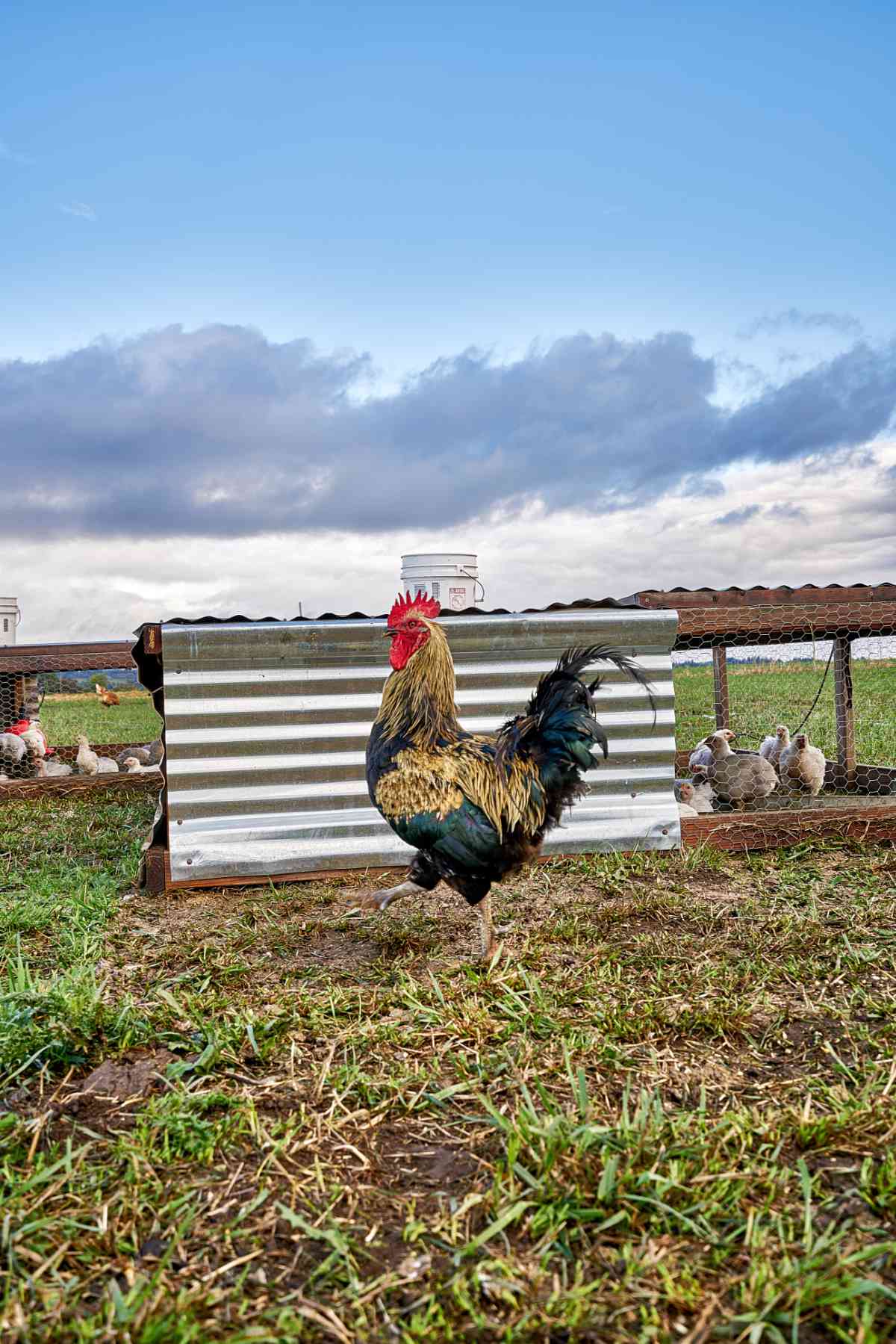
00:32:17:09 – 00:35:44:12, For Consumers
Candice: What should consumers be looking for when it comes to shopping for chicken at a store?
John: Ignore the labels. That’s why I say they should be knowing the farmer and getting to know the farmer and where it’s from, how it’s raised, because there’s a lot of unapproved. Well, I would want to see if there’s no regulation stating what you can see on a label. You can say natural farm raised, free range, whatever it is, and it doesn’t mean a thing to that. Farmers …can’t say organic to the organics, the only one organic. But even that, yeah, you got to be careful with two, because you can have organic chicken raised in a chicken tunnel with 20000 other birds and disease ridden, whatever. It’s just the way they take care of them to feed them.
Candice: So what do you do if you’re at the store?
John: So for I, I go small, go small stores,
Geoff: Maybe it’s the wrong question. If you’re finding chicken at a supermarket, you’re not going to find chicken like this. You know, they won’t be in the supermarkets.
John: And if it is, it’s tucked away in a nice little corner and maybe a couple chickens like there’s a local, it’s probably frozen. Probably frozen. There are pasteurized chickens out there. But it’s very limited because most consumers don’t buy pasture if they think pasture is just like range, but it is. It isn’t. Free range is tunnel chicken that gets a little bit of space outside to go in and out if they want to, which they don’t want on a nice dirt piece of soil. No, I think just again, that’s the whole education thing. Teach people what pasture truly is.
Geoff: Yeah, I guess if I’m absolutely forced to answer…I would say spend the extra money and get organic if you’re at a supermarket. If your choices, conventional mass produce or organic mass produce and buy a whole bird, don’t buy parts, buy the whole bird and make three or four dinners out of it. Learn how to use every last part of that animal. It’s still an animal that had to die. So at least honor it by absolutely using every last drop of this. So don’t throw away the giblet bag if it comes with the giblet bag. I mean, make gravy or grind it up or learn how to eat liver, which I realize
John: Everybody’s got dogs. Everyone I grew up with dogs, dogs will eat that. You know you can make dog food with that.
Candice: Yeah, dog food. People are spending so much money on dog food.
John: It’s kind of like, Yeah, it’s I get mixed emotions when people come in here and they’re buying all this, like these necks and feet and stuff. And I’m like, Oh, looks like you’re going to make some broth? And they’re like, No, I’m going to make dog food. I’m like, Oh, yeah, OK. So I’m like, You know, I want to say, no, you know, some people, just some people, their dogs are more important to them than their own health, like they don’t… There’s someone that comes in every week and buys stuff for their dogs, but doesn’t, not for themselves.
Candice: Maybe they’re vegan.
Geoff: We did have a vegan person here a couple of years ago. She would come in and buy top notch stuff for the dogs like tenders
Candice: My brother’s girlfriend, she’s vegan and she says, you know, my dogs, they’re not vegan, right, they’re not meant to eat that way. So she feeds them like that. She’ll go to stores like this, you know, to buy the meat…But I mean, the dog food industry is a whole other beast. Yeah. OK. Thanks for trying. Really hard to answer that. I know it wasn’t an easy question because it does go against your practices. And at the end of the day, there are people who don’t have access to stuff like this.
Geoff: I think, you know, a whole bird is going to…Your money is going to go way way further.
Candice: I don’t know if you know who you’re talking to. I have a food blog and I encourage that. That is what I encourage…So yes, I will continue to do that and now have quotes from you to back that up.
Geoff: For a long time, we really resisted getting into cuts for that very reason. Yeah. Why would we want to encourage the thing that we’re telling people not to do? Right? But not everybody is going to do it. And then when you start offering cuts, people are like, Yeah, really? All the cuts.
Candice: I haven’t bought just a cut of chicken in at least eight years.
John: It’s easy. I mean, it’s really easy to take on some tenders to a family of six, which I have, you know, and cook up tenders for the topping on your salad. Yeah, it…stores better, I would say, in the freezer, too. Then they come and get the bowling ball…and kind of spill out. And there’s that.
Geoff: So we yeah, we price we are the processor for a fairly large firm down in Eugene, they bring their poultry up here and we process them, process for them. Last year we did all whole birds and we saved some parts and stuff, like livers and hearts and stuff. This year we started really kind of leaning into co-packing for people, which means the vacseal thing and doing a significant amount of cut up for people. So they tried it. They’re like, Okay, can you cut up 50 birds? And we worked out how many to vac seal and everything. So we’re set up for that now. And so we did that well. Just yesterday they brought 500 birds. They wanted half the birds coming up and vac sealed. And there I was like, Well, we can do that, but we have a little bit of a challenge on staffing and stuff like that today. I’m not sure if we’re going to get all 250 and you said, OK, you know, I totally understand, do what you can, and we got 200. But he was adamant that the next time he shows up, he wants to make up the difference that we didn’t get. And it’s because he’s found the same thing that we have. You put cuts on the shelf. People are going to buy the cuts and the cuts are flying off the shelves
John: But there’s also like we do have birds that have damage too, and you want to use that bird. You know, cut off the part that got damaged in the processing part and save the rest instead of just tossing.
Geoff: That’s how that’s how we got into doing cuts. It’s like, Well, we have a bird that’s got to see a broken window. You can’t sell that as a whole bird. But there’s a lot that
Candice: You can’t, you can’t just say damaged wing and, and charge five percent off?
Geoff: Your feet. Yeah, I would feel bad about putting that on the shelf. I would not want it to seem deceptive…well, and I don’t ….telling people that this is a second and there’s a certain quality.
Geoff: I want to be proud about what’s on the… And there are some just, you know, wings are just not salvageable, but everything else is good on it. So we started cutting those birds up. And now we’re, you know, people are buying people or buying the cuts like,
Candice: I saw you had carcasses now I was like, Oh, I’ll make some stock and buy a bunch of those.
Geoff: I think we sell every part of the bird, except for the…So that’s great. We had a request for intestines. We just can’t do that. I would be very concerned about being able. First of all, to clean this super labor intensive cleanup because they’re so skinny. They’re skinny, they’re delicate. And if you can’t get close like it has to be totally clean.
John: Yeah, because the three chemicals used are caustic.
Geoff: If there’s one piece that’s going to have salmonella, yeah, it’s going to be the intestine, right? So I was like, No, you’re right.
Candice: Man, how tall? How thick of a sausage are we even talking about?
Geoff: It’s, you know, in the bird itself, it’s maybe pinky. Thank you. It’s so I don’t know. I don’t know how far they stretch. They break. I know that they’re not tough.
John: So they make better compost.
Geoff: They do. I’d rather put it on the field in its compost form.
00:40:12:19 – 00:43:21:03, Hopes
Candice: All right. Last question for now. Anything you want to add that you would hope would become a common practice with all chicken farms and processors.
John: I think really put a top priority on humane raising of animals, you know, like humans aren’t going to do well in a confined space. So why should animals have to do that? You know, especially cows and big animals like pigs? And I mean, it’s sad to see… I mean, just you can go, you sit here just a couple of hours and there’s, you know, a plot of land that’s got thousands and thousands of cows on it. No grass. They’re being fed corn and Skittles. I mean, if you were fed corn and Skittles every day, you probably wouldn’t be healthy either. So how’s that meat good for you? You know, and it doesn’t treat the animal right and the cows aren’t supposed to eat corn and skittles. Maybe they found it on the ground laying on in the pasture or something, but that’s not their main diet. So I think that’s number one for me.
Geoff: I wish it was more common that people would know their farmer that they were getting chicken from. I think if we could go back to making what was once normal normal again, it’s not new. We’re not talking about anything that we’re doing here that is not necessary.
John: You know you go to Europe and this is common. Yeah, especially France and Italy, they’ve… the model is just not that long, you know?
Geoff: So again, I have been speaking with somebody on this exact topic, and he was telling me what’s going on in India right now? Oh, India. And they had instituted or had proposed a whole bunch of agricultural reforms that were really good for small farms and family farms and would have really made it economically viable for so many people. I got to thinking about that as we were talking, and I think what happens is in any kind of a democracy, there are more voters who want cheap food than there are that want sustainable small farming, and you can’t be a politician and advocate for policies that make food more expensive. Ultimately, you’re going to be the one that advocates for cheaper food, which is why and that’s where India is. So India has not implemented those reforms, is writing right now the demonstrations that are focused on that, and they are slowly but ever so surely moving towards the American food model that will turn, you know, portions of their country like, you know, the Midwest is here, that grows, you know, three things, which is kind of sad, but I got to thinking about what would be the incentive to do that. And it’s like, Well, maybe, maybe it’s tough to get people to vote for you if you’re advocating for, in the end, more expensive food.
Candice: That’s where money’s coming from, too. It’s like these huge corporations are sponsoring
John: Big corporations have more control. Sure, Cargill would love to get into India. Think of evacuation there.
John: It’s all about money. A lot of money.
00:43:22:01 – 00:45:59:15, Normalizing Sustainability
Candice: So knowing your farmer right, how do we make that normal in other parts of the country even? People in L.A, for example.
John: People like us just need that. We need to strive to be successful, not in a successful capitalistic way. You know, I got to have a five million dollar home type way, but successful in that. You can do this and have a sustainable lifestyle. That’s not the right word, I guess. Well, if you
Geoff: If you don’t want lots of things, then you don’t miss lots of things. And if my priority is in getting the new iPhone every time it comes out, then maybe that changes.
John: I think when you’re doing this, the way we’ve done is change my mindset the last 12 years to like I’ve gone from, you know, yeah, I want a nice, comfortable house to live in to I want a tiny house now. You know, I’m seeing all these potential things to live off grid and live that, you know, that lifestyle that is iconic of the old ways, you know? And I think seeing what we do here and seeing what works and doesn’t work and how like, yeah. The temptation is to go big. But why, you know, let somebody else go out and do this too, locally. You know, we serve a small portion of the population tiny, tiny, tiny fraction. I would say based on what we see here in the market, it’s probably a radius of 50 miles that the majority of our people. But that’s just 50 mile radius in Oregon that’s huge. You know, these things can be popped up anywhere in the state and do the same thing. It doesn’t have to be chicken. It doesn’t have to be beef, but it could be a veggie farm that opens up a farm stand or a pig farmer who’s got like pigs but wants to be able to bring in local food and different things like that. You know, so I think doing something like that and making that more commonplace will help change the way people do it because we get people in here all the time. Oh, I’ve never. This is new for me. I’ve never done anything like this and they’re back…You know, we’ll come back and they’ll buy it because it’s all local. I had no idea. There’s this much food you could actually eat year-round with locally produced food
Candice: In Oregon. Yes, in Oregon.
John: And but most of the United States.
Candice: You think so?
John: Oh yeah. I mean, you can go and we’re still the same diet. Upstate New York, there’s farms like this out there. I don’t know why it totally did.
Geoff: Why would that be such a shocking concept? If we roll back 200 years, we were all eating. We were very sustainable.
John: Well, no, I would say downtown Chicago. Yeah, it’s a little bit harder.
Geoff: Yeah, food deserts. I think man created food deserts are definitely a separate issue,
John: But there’s movements now that produce, to do farming on top of buildings and cities. I think that’s awesome. I think that’s what we should be doing is getting back to like, Yeah, can we? There’s an empty piece of property that someone had a car lot on one hundred years ago or, you know, whatever, ten years ago. Let’s tear up the asphalt or even plant on top of the asphalt seeing people doing that. Because if you leave land like that empty for a few years, weeds are going to take over. Nature always does.
Geoff: Nature abhors absence on the soil and she will fill it right. Whether you’re working or not, she never stops working
John: The ways. One hundred years ago, a lot of them didn’t work very well because they didn’t have the technologies we have now. We didn’t have the technologies and the sanitary practices that, like, for instance, slaughtering a hundred years ago. If we tried to slaughter animals like they did in Europe for thousands of years, it would be really hard to do here in the United States because we didn’t have access to some of the things they knew and some of the old world skills that they had. Now we can do that because we have access to hot water. I mean, it’s readily available where everyone’s got hot water, uhh bleach. It’ll kill some of the bacterias that will grow on the countertop.
Geoff: Yeah, most of the stuff, I think probably will be taken care of.
John: I think most people realize now, yeah, I can’t leave, you know, a piece of meat on the table for two days and think that it’s going to be OK and not grow bacteria open
Candice: Their meat markets are not, right.
John: Well, in France, though, they do that there.
Candice: They do a lot of places.
John: And I think it’s hard to convince the regulatory authority that that’s OK to do now, especially with some of the salts and some of the carrion things that you can put in the meat. I’m just speaking like meat. It can. It could be done today and it could be done, I think, in a better way with control, you know, temperatures and humidifiers. And you know, there’s so much available to us today to go old school.
Geoff: I think, you know, like the field, the things that we have now to allow us to grow animals in this way did not exist. You know, gravity fed water systems. So the electric all of the electric netting and the electric poly wire. So being able to set up paddocks for the cows don’t have any cows right now, but the pigs are a good example. How many pigs do you have at what time of year it is? You change the size of the paddock that they’re in for that, and every time they move, you’re able to be 100 percent flexible because it’s, you know, poly wire that’s this thick. It’s super lightweight, easy to move. We don’t have poly wire, you know, 20, 40, 50 years ago, you couldn’t do that, right? I think the bell waters that are inside of the, you see a couple of them away over there. They’re the red things on top of the, those hanging inside the chicken tractors. It’s completely gravity fed. What John was saying, super well engineered and fairly inexpensive for what they are, but we couldn’t run chicken tractors without a watering system like that. It just wouldn’t work. You’d have to have a hose on everything, and it would be you just couldn’t do it. So the modern stuff has really allowed us to roll the clock back.
John: And it’s allowed us to go forward too, I think, you know, mass production of chicken in big facilities like Costco. I’m sorry, I’m not supposed to name a place, but I mean, yeah, allows that to happen more successfully, I guess. But it’s cheap, you know, and it doesn’t provide more jobs for people, necessarily. It does provide a few jobs in that community, but it just gets better. Cheaper chicken for Costco. Yeah, in the very back of the store. So people walk through the store to shop, it’s Yeah, yeah. And it smells great. I used to like Costco Chicken and I had some. The other day. I was like, Oh yeah, I’ve completely been ruined on chicken.
Candice: Yeah. You just can’t go back. Just encourage people to eat less, less, less, smaller portions of the good stuff.
Geoff: Fresh tuna is another one. I can’t eat tuna out of a can anymore.
Candice: I work with Copper River Salmon and I’m very spoiled.
Geoff: Even, so what ruined me was going fishing for tuna. He’s a friend of mine. And you know, that leads inevitably because when you come back with 100 hundred pounds of loins, it inevitably leads to learning how to conduct yourself at home. So you run the counter for like a week straight trying to because you don’t want to freeze it. It’s fresh, you know, do it while it’s still fresh, and then you crack open one of those jars and it’s like, This is nothing like, let’s put the fresh, you know, loin on the barbecue aside for a minute, because that’s not a fair comparison, right? You can that stuff yourself and you compare it to the stuff in the tin at the store. It’s not even the same.
Candice: No, not easy. And you don’t have additives, you know, it’s it’s own fats. After that, you should take some awesome parts of that tuna and just freeze it overnight and then slice it sashimi because you could eat it raw.
Geoff: Oh yeah, no, we would eat it on the boat. Yeah, we would, you know, loin one out and just start slicing off. Just. Yeah, so good. So you take the belly fat, you know, Yeah, so in every cooking outside, though, every. All right, in every jar I’d put a slice of belly fat.
John: We ate some of your chicken the other night. The canned chicken looks like a year old. I know it’s still perfectly good, but I get it tastes like chicken. I mean, it’s not fresh, but it’s pretty good. We’re like, We’re going to use this stuff. You know, it’s about a year old.
00:52:58:25 – 01:02:46:24, Free Time is Valuable
Candice: Is there anything that you guys do in your free time? Because I know there’s so much of it… to help other people do stuff like this to encourage and teach because you’ve learned so much. You know you’re a treasure trove of information. You probably don’t realize it because you’re still learning. And when you’re still learning, you forget how much you’ve learned. But is there? Are you doing any education for people to be able to
John: Free time for me is valuable, precious time these days. So any time? Yeah, I’ve got four kids all in school still. But if there is any free time away from that whole thing, it’s learning new skills that I can hope to… being that I’m getting older. Forty seven years old. Yes, I am great. Just learning new skills like hunter-gatherer type stuff, you know, like, for instance, I think it’s next week my wife and I are going to go mushroom hunting. Yeah, you know, we do that every year, but we’re going to try to get into that even more this year. And not just the chanterelles, but everything the things that we always thought were edible. But now we know, right? Getting to know a local guy, John Callos. I don’t know if you know he is. He does edible wild plants. He wrote a book about it and he does classes here. A great guy. I’ve been in contact with him and just talked to him about doing classes even out here, like what are the plants that we have on the farm? And he’s like, Oh, that’s a great idea we should do on the farm like edible series.
John: But he is, you know, just learning like, I’m looking out here going, there’s an edible plant there. There were edible plants out in the field today that I walked over, you know, probably need those because I’ve been cooped up. But um, well, you know. Right. And learning the history of a lot too, like wild spinach, which we call Lamb’s quarter, is one of the original cousins to what we have cultivated spinach now. So it’s…treat it just like spinach. You cook it just like spinach. Eat it just like spinach, and it’s plentiful in the northwest. But people spray it and kill it. Yeah, it’s sweet. Yeah, dandelions, you know? Yeah, I’m weird like that.
Candice: People will pull dandelions out of their backyard and then they’ll go by the greens at the store.
John: Yeah, it also…there’s a lady that sells the salad mix in here…their favorite stuff, and she’s got like amaranth and stuff that in Sorrel and dock sorrel that grows out here. And it’s like just because I’ve tried it and there now, I’m more confident that I can go out in my backyard and get the plantain and eat that and cook it down.
Candice: And but it takes education and confidence to know that you’re eating the right thing .
John: And just just learning to be less dependent on others for survival. Yeah. What’s that? Grocery stores, groceries. Yeah, we have a grocery store.
Geoff: Well, supermarket supermarkets.
John: Yeah, I just want to support as local as possible, and when I can’t do it locally, I’ll do it myself. Yeah, I love that. That’s kind of … my wife and I have been dedicated to that for the last year. Just like even to the point of like what kind of property can we buy and how can it support us instead of like buying a house in the city and open, you know, you can grow a garden in the backyard. Now let’s find something cheap that we can build a tiny house, rainwater harvesting, solar off grid, rural food, everything from meat down to veggies. Because one day something bad is going to happen just like a, you know, earthquake that they keep saying it’s going to happen here in Oregon, for instance, and people aren’t going to get their food. I mean, look what happened with toilet paper? Yeah. In fact, I went to Costco yesterday and I went down. The toilet paper aisle, I’m like looking for the boxes for the people we buy for here and it’s not there, I’m like, Oh no, look down there is the aisle and there’s like two pallets, toilet paper, and they have the sign up limit one per customer. Just recently, two weeks ago, they had plenty of toilet paper. I don’t know what happened. So there’s these hiccups in the supply chain, you know? So now toilet paper is a different issue. I think everybody should have bidets.
Geoff: Yes, it’s a lot of drinking water used to.
John: Not if you’re harvesting water and filtering down.
John: Yeah. So I think we need to be managing our water and I don’t understand why we have drinking water in the toilets. And it makes no sense at all. That is one way we get here in the United States or here in Oregon, especially in the northwest. There’s so much rain that you don’t need to, like, Think about how many times you flush your toilet a day. We probably flush it on our family six, six to eight times a day. Sorry. You know, our pooping schedule. That’s six gallons. Seven gallons a day times Three hundred thousand. That’s like drinking water. You can do it. You can easily store a couple of thousand gallons of water in your backyard in a tall cistern and use that for flushing down the drain. So, like you said, drinking water. Yeah, it’s crazy, you know? And drinking water, that’s a whole nother thing. We go down the rabbit hole. I’m not going to go.
Candice: Thank you for taking all this time to talk with me. You guys are awesome.
End of recording.

